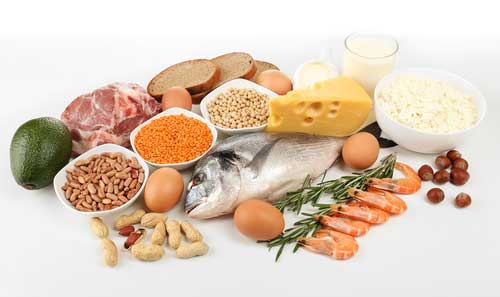
With all the hype about protein foods, you might worry that you aren’t getting enough. In America, it is rare to be protein deficient. However, not all sources of protein are created equal and some choices might not be good ones for a healthy diet. Understanding what protein is, where it’s found and why it’s important is a good first step in making sure you are getting what you need for good health.
Types of Protein
Protein contains amino acids, which aid in a variety of body functions. Some amino acids are considered essential, which means you must get them from your diet. A complete protein contains all 20 amino acids. An incomplete protein lacks one or more amino acids. Complementary proteins are incomplete proteins that, when eaten together, provide all 20 amino acids. Eating dairy and nuts together is one example.
Sources of Protein Foods
Many foods contain protein, so you have plenty of options when it comes to meeting the daily intake recommendations. Meat is a good source of protein and beef, chicken, fish, pork, lamb and game meats count. In addition, eggs, beans, peas, milk, cheese, yogurt, shellfish, nuts, and seeds also contain protein. Soy foods, such as tempeh and tofu, are other options that supply protein. The amount varies, but including a variety of protein foods in your meal plans is an easy way to ensure that you’re getting enough.
Intake Recommendations and Servings
The U.S. Department of Agriculture recommends that adult women get 5 to 5 ½ ounces of protein each day. Adult men need 5 ½ to 6 ½ ounces per day. To get an idea of what counts as a serving, which is measured in ounce portions, measure your foods on a kitchen scale. In general, a small steak, can of tuna or chicken breast is equivalent to about 3 ounces. Three eggs count as one protein serving, as do a tablespoon of peanut butter and a ¼-cup of beans, according to the USDA.
Health Benefits
Protein plays a role in many of your body’s functions. Meat sources contain B vitamins, which help convert your food into energy, aid in tissue function and help your body form red blood cells. Protein also promotes healthy skin, hair, nails, and hormones. Iron, which is available in many protein foods, helps transport oxygen throughout your body. Some protein foods contain magnesium and zinc, which contribute to healthy bones and a properly working immune system, respectively.
Making Good Choices
Some forms of protein are healthier options than others. The USDA recommends choosing lean cuts of meat, which reduces your intake of saturated fat. Remove skin from chicken and turkey to keep fat content minimal. Eat seafood a couple of times per week. This allows you to get plenty of protein, but it also contains omega-3 fatty acids, which are important for heart health. Cook beans and peas with limited fats and choose unsalted nuts to control your sodium intake.
Considerations
By choosing a variety of protein foods, you can protect your health, feel great and keep from getting bored eating the same meals all the time. Keep in mind that too much protein isn’t always a good thing. It can strain your kidneys and cause dehydration. The Centers for Disease Control and Prevention recommend 46 grams of protein each day for women and 56 grams for men.
Related Articles By Cathe:
How Much Protein Do You Really Need in Your Diet?
2 Factors That Determine the Quality of a Protein
Pros and Cons of Eating Plant-Based Protein
Plant-Based Protein: Why You Need More of It
4 Reasons Boosting the Protein Content of Your Diet Can Help You Lose Weight

